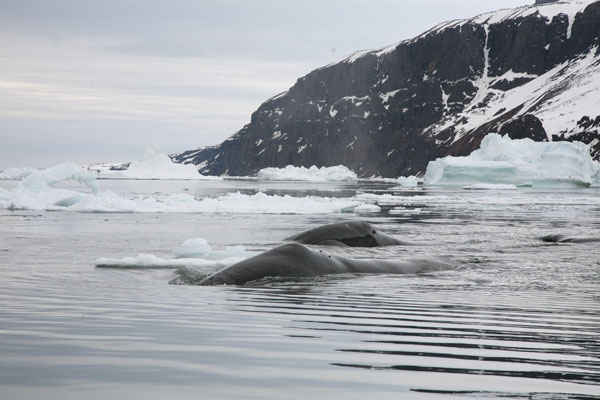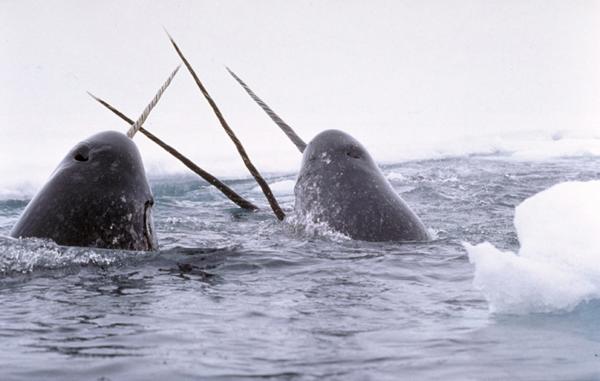
Enchanting Whale Songs, Stories of a Changing Arctic

NEW YORK — By tracking and listening to whales, scientists have unlocked secrets about the dramatic changes currently underway in the Arctic. They've also learned that these whales are talented singers.
In a wide-ranging talk here at the American Museum of Natural History, researchers and a documentary filmmaker revealed how declining levels of ice have affected the Arctic, as well as the humans that dwell there. Their stories, recounted during a session of the World Science Festival, billed as an annual celebration and exploration of science, reveal the difficulty and beauty of working in the harsh, and quickly changing, environment of the far North.
There, ice is paramount to the traditional order of life. "Ice in the Arctic is everybody's best friend," said Kate Stafford, a researcher at the University of Washington. "All animals and people depend on it." [On Ice: Stunning Images of Canadian Arctic]
Whale song
Stafford has used special devices to listen to the songs of bowhead whales, which has allowed her to track their movements and estimate their populations. In a 2012 study, she heard many more bowhead calls than expected, suggesting that the huge beasts — once hunted to the brink of extinction — may be rebounding. The songs were also more complex than those of other whales, sounding almost like a bird's song, she said.
Stafford also found that, in some cases, bowheads in the Fram Strait, east of Greenland, seem to prefer hanging out under old, thick ice. This is perhaps because the ice acts as a better "theater" in which to broadcast their beautiful calls, or perhaps it offers more protection from killer whales, she said. As ice continues to dwindle in the Arctic — 2012 saw the smallest extent of winter ice ever recorded — killer whales can advance farther north, pressuring even the enormous bowhead whales.
'Unicorns of the sea'
Sign up for the Live Science daily newsletter now
Get the world’s most fascinating discoveries delivered straight to your inbox.
University of Washington researcher Kristin Laidre shared the experiences she's had with narwhals, also known as "unicorns of the sea." She recounted the difficulties involved in attaching satellite tags to these reclusive whales, which live far offshore and feed more than 1 mile (1.6 kilometers) under the surface. But her persistence has paid off, and she has been able to attach tags to several of the animals; the tags record where narwhals go and the temperature of the water they swim through. This data has been inputted into computer models that have allowed researchers to better understand the Arctic climate, Laidre told LiveScience. "The whales sample the ocean for us," she said.

Sarah Robertson, a documentary filmmaker, has witnessed male narwhals "jousting" with their long tusks, which are actually teeth. Contrary to its name, though, jousting is a rather gentle affair, where males cross tusks and slide them against one another. "You get the sense that they don't want to hurt the other," Robertson said.
Once again, though, the whales acted as sentinels for larger changes. Robertson witnessed the animals jousting while traveling with Inupiat guides, who knew from experience that this rare behavior only takes place in the spring, just before the ice breaks up. Sure enough, 12 hours after the whales jousted, the ice gave way. "Clearly, the narwhals knew something we didn't," she said.
Angels in the abyss
Researchers also discussed their experiences with beluga whales, also known as "canaries of the sea" because of their beautiful songs. Robertson has made many dives in the frigid water to document the pure-white giants, which "glow like angels in the dark abyss," she said. One time, a beluga echo-located right in front of Robertson, bouncing sound beams off her body. "I was scared," she said.
Scott McVay, who was the first to document the six-octave song of the humpback whale, recounted the time in 1973 when he captured the first-ever video of a bowhead whale from the air. With only minutes of fuel left in the helicopter, his team captured a bowhead rising out of the water and blowing out water. He read a poem to commemorate the event. "Miracles sometimes stand alone," went one of the lines.
Perhaps human performance isn't appreciated only by humans. Musician Garth Stevenson told the story of the trip he took with whale researchers to Antarctica, where he played a piece inspired by a whale song on his bass. Just after he finished, 12 Sei whales approached the boat. "It was a very magical experience," he said. Stevenson played a similar piece during the event while a video of his trip played in the background.
A common thread throughout the event was the changes witnessed by researchers and locals, mostly involving the retreat of sea ice. With less ice, it is harder for subsistence hunters to catch these animals. Likewise, the lack of ice has harmful effects on the whales, which need it for protection from killer whales, and to seek out prey — like Arctic cod — that prefer to live beneath the ice. The researchers are racing to capture data before more changes occur.
"It's urgent to get as much information as possible now," Laidre said. And the whales are helping to do just that.
Email Douglas Main or follow him on Twitter or Google+. Follow us @OAPlanet, Facebook or Google+. Original article on LiveScience's OurAmazingPlanet.











